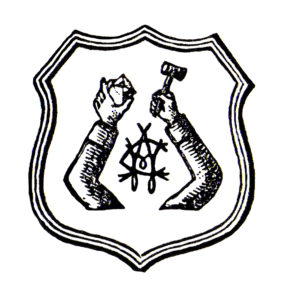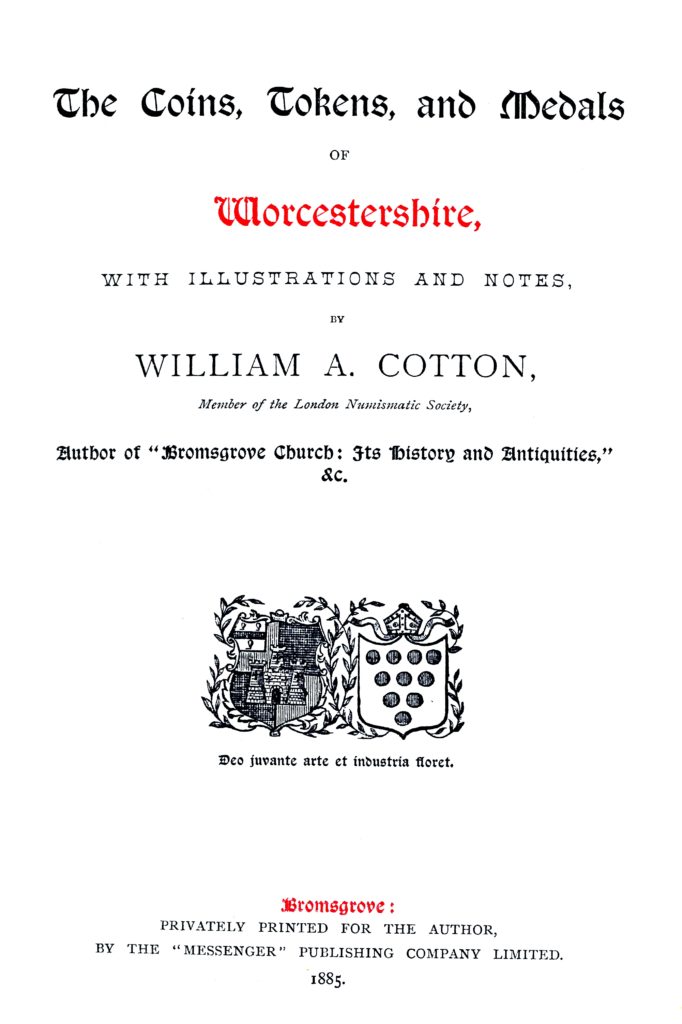William Alfred Cotton (1853-1889)
‘Mr. Cotton’s abilities as a token and coin collector were of a marked order. He was scrupulously exact in details, and punctilious in descriptions, and he possessed a merit that immediately commended him…no tribute can be paid to his memory that is too warm, and with deep regret the Editor deplores the loss of a dear and valued correspondent, helper, and friend.’
George C. Williamson, 1891
William Alfred Cotton was born in Bromsgrove on 31 April 1853. The son of a well-respected local auctioneer, Cotton joined the family business in his mid twenties, and from his office on Bromsgrove High Street acquired a reputation as a competent worker and a particularly ‘good judge of coins, medals, and china’. Everyday business contacts with old Worcestershire properties and curios fuelled Cotton’s passion for local history, which he pursued as both an author and a keen associate of the Bromsgrove Naturalists’ Field Club and the Birmingham and Midlands Institute.

Logo of William A. Cotton, auctioneer
Cotton’s main interest, however, lay in Worcestershire numismatics, and his 1885 work on The coins, tokens, and medals of Worcestershire represents the fruits of more than five years research activity spent studying specimens produced by and for county mints, institutions, and tradespeople. Illustrated by several lithographed plates, including one submitted by the Rt. Honourable Earl Beauchamp of Madresfield Court, Cotton’s book was published on a short run of 80 copies – demand pushing the final number above a planned 75 – and was appreciated by his contemporaries as ‘a valuable contribution to the history of the county’. To date it remains the most detailed and systematic study of Worcestershire numismatics, spanning an impressive nine centuries and illuminated by a wealth of local documentary evidence. Elected to the Numismatic Society in January 1885, Cotton often travelled to London to attend meetings and exchange information and thoughts with his fellow numismatists including, most importantly, George C. Williamson, whose updated edition of Boyne’s 1858 catalogue of seventeenth century tokens drew extensively on Cotton’s original research.

Front page of Cotton’s 1885 ‘The coins, tokens, and medals of Worcestershire’
During the winter of 1888/9 Cotton was struck with Bright’s disease, and by March illness had forced him into an early retirement. As his condition worsened over the following months Cotton made preparations to dispense of his extensive research collections. Desirous that at least a part should stay in his home county, in May 1889 he generously donated a collection of 216 books and pamphlets – including several rare seventeenth century political and religious tracts – to the Worcester Public Library, and the portion of his numismatic collection sold at Sothebys on 27 May 1889 had been carefully pruned of any Worcestershire specimens. Seeking convalescence in the early summer, he relocated to the seaside resort of Ventnor on the Isle of Wight where, after a short but painful illness, he died on 20 June 1889. In June 1892 Cotton’s elder brother – the noted architect John Cotton – fulfilled his sibling’s wishes by bequeathing the Cotton collection of 268 Worcestershire tokens to the Worcester City Museum, where they continue to serve as an essential resource for students of the series.
Bibliography of William Alfred Cotton (1853-1889)
Cotton, W.A. 1879. The antiquities of Bromsgrove. Bromsgrove: Charles Evans.
Cotton, W.A. 1881b. The old houses of Bromsgrove and neighbourhood and their associations. Bromsgrove: Charles Evans.
Cotton, W.A. 1882. The early government of Bromsgrove, and its ancient customs. Bromsgrove: The Messenger.
Cotton, W.A. 1885. The coins, tokens, and medals of Worcestershire. Bromsgrove: The Messenger.
Cotton, W.A. 1886b. Extracts from the Calendar of State Papers having reference to the history of the city and county of Worcester, 1547-1667. Bromsgrove: The Messenger.
Cotton, W.A. 1886c. An account of early British & Roman coins found at Hanbury, Worcestershire. Bromsgrove: The Messenger.
Cotton, W.A. 1888. The Regal mints of Tamworth, Warwick and Coventry. Birmingham and Midland Institute Archaeological Section. Transactions, excursions, and report. 15. pp. 27-57.
